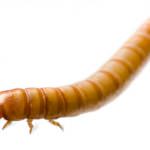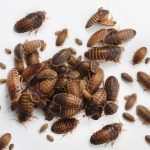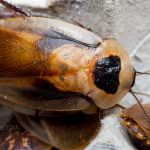They say hind sight is 20/20. There are several things that I know about keeping tarantulas that I did not know when I first started. The World Wide Web was in its infancy back then and the hobby was too, so it wasn’t like there was a wealth of information out there for me to look up. Today, however, the opposite is true. There are numerous tarantula keepers out there who are willing to share their experiences and provide tips on how to better keep your eight legged companions. This is such a page. I will add to this as more things come up that I learn or feel that I need to share.
Urticating Hairs!
The fact that most New World tarantulas have urticating hairs is not a mystery. It’s one of the first things people warn you about when purchasing a New World tarantula. What I did not know (It seems like common sense to me now) is that a tarantula’s enclosure is an urticating hair bomb waiting to explode. I learned this the hard way when I was cleaning my Grammostola Rosea’s enclosure. While you do general maintenance on a tarantula’s enclosure, I felt like my G. rosea’s enclosure was due for a complete cleaning so I set out, bare-handed, to scoop out the substrate and wash out the aquarium in my kitchen. After I was finished, I noticed that I began to feel itchy on my face, neck, and arms. My arms were so bad I felt like I had been rubbing them in fiberglass! Then it hit me. Every molt, every time it flicked hairs, the hairs were settling into the substrate of the enclosure. When I disturbed the dry substrate I kicked up a cloud of urticating hairs all over and around me. I felt much better after taking an immediate shower but I still itched for a couple of days after that experience. I’m itching right now just thinking about it!
A word to the wise. If you’re going to clean your tarantula’s enclosure, make sure you do it outside. You may want to wet down the substrate to keep hairs from flying prior to cleaning. It is also a good idea to wear gloves and/or a surgical mask to protect yourself from any flying urticating hairs. I was lucky that I didn’t breathe any or get them in my eyes. Keep in mind that some species possess urticating hairs that are worse than others.
Where To Buy?
There are several options for you to purchase your tarantula(s). Let’s explore them and look at the pros and cons.
Pet Shops
A pet shop seems to be the most logical place to buy a tarantula but it may not be the best one. Most pet shops will have a huge mark-up on the price of their pets. Usually the people that work there will not know much about the species you are buying, other than general information. Most pet shops will only have sub-adult or adult tarantulas which usually demand a higher price. Most pet shops will only have a very limited variety of species. Note: There are pet shops that specialize in exotics and may offer better information and a wider variety of species. Usually you will still pay a higher price at exotic pet shops.
Exotic Animal Shows
Exotic animal shows/Reptile shows are known for having arthropod vendors. Many of these vendors carry a fairly wide variety of species at reasonable prices. The prices I have seen at these shows have always been lower than anything I have ever seen in a pet shop. It’s been my experience that most of these vendors carry a large variety of slings (spiderlings) and only a few adult/sub-adult species. The good news is that slings can be very cheap, depending on species. You can buy multiples of the same species, or buy several different species and not break the bank. Of course it’s always a gamble as to the sex of the sling but that’s part of the fun. Exotic animal shows can be fun because many vendors are willing to make deals if you buy multiple items. It’s always worth a try to simply ask the vendor, “If I buy all these will you give me a break on the price?” Almost every time I’ve tried this the vendor will usually bring down the price a few dollars or throw in some freebies. Keep in mind, these vendors don’t want to go back home with most of their stock.
Caution: Avoid vendors who don’t know what they have or don’t know about their specimens. Ask questions. If a vendor acts like he/she doesn’t have a clue, they may not be the best person to be buying from.
Facebook and Other Social Media
Social media is a great way to connect with like-minded people. There are many arachnid groups out there that you can join to meet people who are in the hobby. There are some devoted specifically to sales and others that provide feedback on vendors and some that are just for enthusiasts to share photos of their collections. Social media is a good way to connect with people who have small collections but are successfully breeding their tarantulas and need people with which to sell and trade. Technically, selling without a license is illegal but it happens all the time and doesn’t seem to be very strictly enforced. Many times you find people who are local to your area and you can meet places and conduct a sale or trade.
Caution: Dealing with people you don’t know or trust can lead to your money being stolen. I’ve read many cases on tarantula groups I belong to where a person has purchased tarantulas from someone and the person never shipped them. Be sure to check the person’s reputation before buying from them. Many of the groups will have feedback on vendors so you know who to trust and who to avoid. Buying from someone who is not local means that your tarantulas will have to be shipped. Most of the time you will have to have them shipped overnight. This can cost as much or more than your tarantulas at times. Many will charge a flat rate of $40-$45 but others may end up charging you more. I had a guy charge me $60 for shipping. When I balked at the price, he agreed to throw in an extra tarantula to offset the price. Fortunately for me, he did as he promised but it was a risk I took.
Buying Directly From Dealers Online
Probably the best way to purchase tarantulas is by purchasing directly from dealers online. These dealers know exactly what they are dealing with. Many are licensed breeders and importers and they usually have a large variety of species available. Their prices are usually very reasonable, but rare species can be very pricey. Shipping is always going to be involved with dealers. Most will insist on overnight shipping and it is usually a flat rate of $40-$45 so that should always be included in your budget before you even start looking for what you want. Dealers will offer you a Live Arrival Guarantee (LAG) on overnight shipping. Some dealers will offer a 2 day delivery during times when the temperatures aren’t too hot or too cold but most of the time they will not honor LAG if you ship 2 day. 2 day delivery usually runs around $20-$25.
Some reputable dealers include the following: Ken The Bug Guy, Jaimie’s Tarantulas, Backwater Reptiles, Fear Not Tarantulas, Net Bug, and my personal favorite Pet Center USA.
Note: Pay attention to minimum order requirements. Dealers have a minimum order requirement in order to offset the price of overnight shipping. Overnight shipping usually costs more than their flat rate. The cool thing about ordering tarantulas online is that you can order many tarantulas and the shipping will be the same.
Food
Tarantulas are opportunistic eaters and they will eat anything that they can overpower. When I first started keeping I had already been keeping reptiles, so having crickets in the house was nothing new. However, I wish I had known what else was available because I would not have wasted so much time with crickets if I had known better.
Crickets

The staple for most insectivorous exotics pets has always been crickets. They’re easy to obtain. Most pet shops keep some at quite expensive prices as far as I’m concerned. If you live in an area where fishing is popular, your local bait and tackle store usually will sell crickets at lower prices. If your need for insects becomes great you can always order directly from cricket suppliers online. I had always purchased crickets for all of my insect needs. I had even gone so far as to breed them but the odor that they produce is so overwhelming and I had always found it difficult to get them past the nymph stage that I pretty much quit and continued to purchase them from my local bait and tackle.
There are several negative reasons why I no longer feed my animals crickets. First of all, they smell horrible. I usually keep them in a cricket cage with an orange for them to eat and hydrate and they usually last about a week before I have to buy more. Another reason I no longer keep crickets is that they are cannibalistic. If you forget to feed your crickets, they will quickly turn on each other and eat one another for sustenance. The last reason I no longer use crickets is that they can also eat your pet. Crickets are omnivorous and they are not above biting or feeding on your pet. This may be just a nuisance to a larger reptile but when you’re talking about a tarantula it could be fatal. There are times when tarantulas will refuse meals, usually right before they molt, and the cricket will be left running around the enclosure to do as it pleases. Eventually the cricket will get hungry and will turn to the nearest source of food, your pet. With a spiderling this could mean the loss of legs or even death.
Mealworms and Superworms


Mealworms (Tenebrio molitor) and Superworms (Zophobas morio) are different species but very similar with the exception that mealworms are smaller and superworms are get large. Both are relatively easy to breed, however superworms require a bit more effort. Both have been somewhat frowned upon in the pet world because of their high chitinous exoskeleton and they are said to lack much nutrition. Most people recommend they are given only as a treat because they have a high fatty content. This does not mean you can’t feed them to your tarantula but I would advise against it. Both worms have strong mandibles and are capable of harming your pet. These worms are quick to burrow under the substrate and get lost by your tarantula and they can chew on your pet when it is most vulnerable. I have read of a case where a woman had fed her G. pulchra a mealworm. Assuming the spiderling had eaten the mealworm she didn’t think any more about it until the next feeding day. When she opened the enclosure, her tarantula was gone. There was nothing in the enclosure. When she dug around the substrate to see if it had burrowed she found a single live mealworm and a few legs that remained of her tarantula. It was a very expensive lesson for her to learn that I wouldn’t wish on anyone.
Roaches
Many of you are getting the heebie jeebies about now at the mere mention of roaches but I highly recommend roaches as the best source of food for your tarantula. There are many varieties of roaches that are available as feeders but I’ll only be discussing two: The Dubia Roach (Blaptica dubia), and the Discoid Roach (Blaberus discoidalis).
Dubia Roach

The Dubia is the roach I most highly recommend. They are soft bodied and have a higher nutrient content than crickets. They are not cannibalistic and they do not bite. They can get quite large for your larger tarantulas and the nymphs are small enough for your spiderlings. They don’t produce much odor at all (when their tub gets dirty it tends to have an earthy smell like dirt.) They are very easy to breed and keep on hand. They can’t climb smooth surfaces so this makes it convenient if you wish to breed them. All you need is a plastic tub with ventilation, some egg flats for them to live in, and an undertank heater. Males and females are sexually dimorphic so it’s easy to tell which is which. Adult males have wings while adult females do not. Keep them fed and soon enough you will have an active colony for you to feed your animals whenever you need. If you have reptiles or amphibians to feed, they are great for them too. Unfortunately they are illegal in Florida and from what I’ve read you can no longer purchase them in Tennessee. This leads me to the next roach.
Discoid Roach

The Discoid roach is very similar to the Dubia and it is legal in Florida. Discoid roaches are not as soft bodied as Dubia so their chitin content may be higher (This is not really a concern with tarantulas). They grow larger than Dubia. Other than that they have very similar characteristics including the odor. Basically, they are Florida’s substitute Dubia. They can not climb smooth surfaces and general husbandry is basically the same. Males and females are harder to tell apart as both adults possess wings but with some experience you can tell them apart. Personally I use Discoids because I live in Florida. I purchased 20 adults and 100 small nymphs at a reptile show. About a year later I now have 2 large tubs full of roaches that I use to feed my tarantulas, many bearded dragons, frogs, and geckos.
A Final Note: What if you end up with more roaches than you feel like you need? Dubias and Discoids are relatively expensive. Adults sell for about $1 each and I paid $20 for a deli tub of 100 small nymphs. If you can breed them successfully, you can sell small starter colonies to fellow tarantula enthusiasts for more tarantula money!
